Variety of fireplaces
The range of bio fireplaces is truly impressive. Models can be stylized as "real" vintage units or have unusual futuristic shapes. There are several classifications of bio fireplaces. By location, they are divided into four types:
- Wall-mounted;
- Mobile or portable;
- Suspended;
- Embedded.

They are also classified by shape, size, material of performance and stylistic affiliation.
Wall
These biofireplaces are installed on the wall, as the name implies. Usually they have a slightly "flattened" shape and shallow depth so that the device does not protrude much forward, which does not look very attractive. The model is convenient for small rooms, where there is little space even for furniture. The biofireplace has three viewing angles and occupies an accent wall, where additional decor next to such a magnificent decoration will be superfluous. Although wall units are usually fitted with a glass door, there are open top models. Before installing them, it is imperative to ensure that nothing hangs over the biofireplace.

Portable - floor and table
A portable fireplace is considered the best option for a gift. It can be placed on the floor, table or any other surface, since the lower part of the unit does not heat up and will not bring any harm to it. The mobile fireplace is easy to move to a new place or move to another room. It has four viewing angles and even offers a central location. Portable floor models usually have impressive dimensions and look more like the original fireplaces. Table-top units perform an exclusively decorative function and are distinguished by their miniature size. They are classified into bio-flasks, bio-bowls and bio-candles.

Suspension
Suspended models are perhaps the most original of all. They are fixed to the ceiling and do not touch the floor. The main convenience of such biofireplaces is manifested when cleaning the room. Cleaning the floors becomes much easier and you don't have to move anything. Of course, hanging options look unusual, stylish and very beautiful. Most often they have a round or oval shape and can have either one viewing angle or four if the side walls are made of glass.

Device characteristics
Modern fireplaces are able to impress with their design and perfect designs, as well as style of decoration and various forms.
If we talk about the basic design of such a fireplace, then this is a frame, which includes a fire-resistant metal alloy or vermiculite. A fuel block is placed inside this frame. Its volume is different and depends on the parameters of the frame frame, as well as on how long it is designed for burning.
The combustion process can be from 2 hours minimum and up to 5, 5 hours maximum. The height of the flames also varies, the smallest indicator reaches 15cm, and the largest one up to 25cm. There are models that allow you to enjoy the spectacle a little longer.
 Among the advantages of biofireplaces, it is worth noting excellent operational properties and original appearance.
Among the advantages of biofireplaces, it is worth noting excellent operational properties and original appearance.
The fireplace is installed in a pre-prepared niche place. Its depth should be between 15 and 20cm. The structure is installed and fastened with bolts, which should be included with the fireplace. Other additional communications are not required.
Advantages and disadvantages
Bio fireplaces have a number of undeniable advantages:
- Environmental friendliness. Bioflame does not emit soot, harmful gases, soot and other products of "traditional" combustion. Only water and carbon dioxide.
- Easy to install. The units can be installed in a house, apartment, office and at the same time there is no need to carry out large-scale construction work, connect the hood and coordinate changes with the fire brigade.
- Biofuels are compact and you can forget about the problem of storing wood stocks.
- Easy to operate and maintain. In any model (mechanical or automatic), you can easily adjust the intensity of the flame or completely extinguish it with just one movement of your hand. Biofireplaces are washed every few months with plain water.
- Mobility. This advantage only applies to portable units.
- A wide range of models and stylistic versatility.
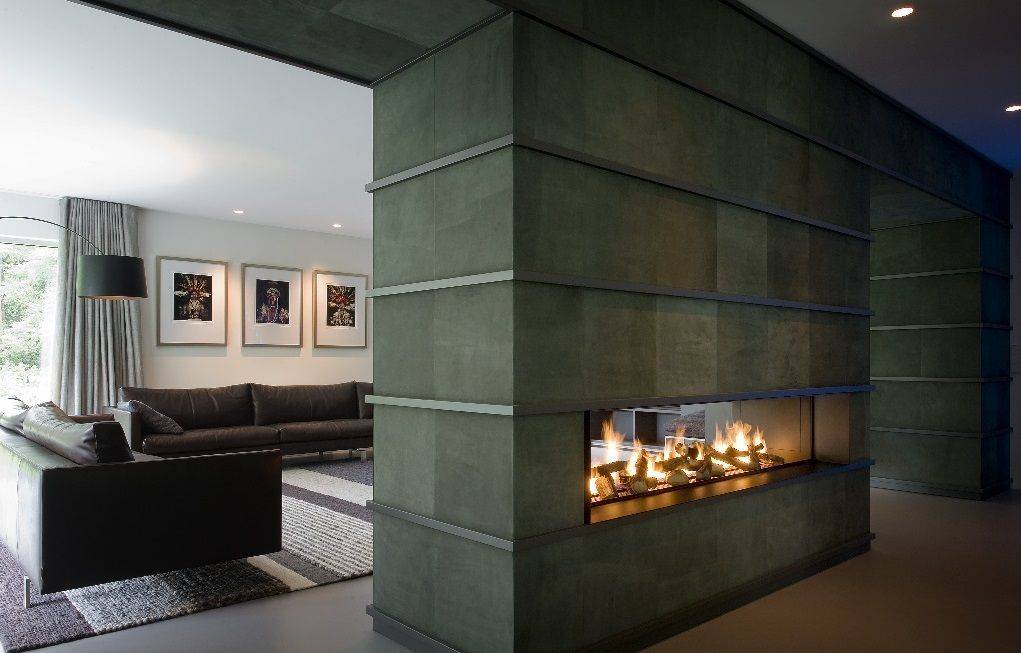
Of the obvious shortcomings, they note:
- The prefix "bio" does not mean at all that the flame from such a fireplace cannot set something on fire, even if it does not produce sparks. Fuel is a flammable liquid that is potentially dangerous in the careless hands.
- High cost. Both the units themselves and the fuel for them will cost a pretty penny. Taking into account the combustion rate (500 g per 1 hour), with regular use, you will have to prepare your wallet for serious tests.
- The biofireplace has a decorative function. It will not provide the room with full heating and you cannot cook porridge on it in a kettle.
Biofireplaces have many times more advantages than disadvantages. In addition, some disadvantages (cost) will eventually disappear altogether, since so far the units are considered a curiosity.
How to choose built-in biofireplaces
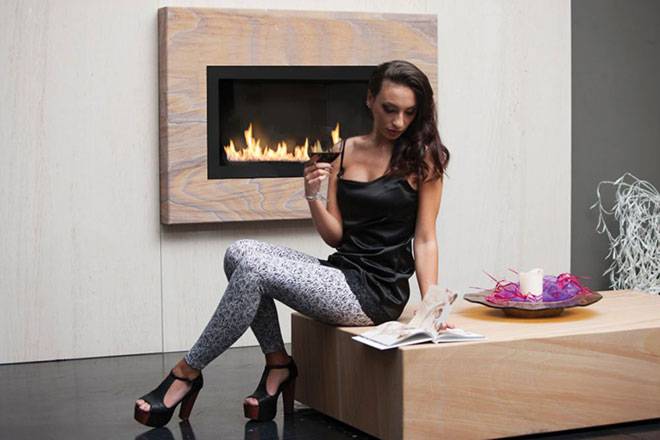
In order to build this kind of furniture into a wall niche, only a 20-centimeter depression is required. After completing the entire range of preparatory work, it remains only to fix the product with bolted connections. The use of any thermal insulation material is not required. Each product, regardless of size and cost, already has its own protection against overheating of the elements of the room.
 Required depth in the wall for installing a bio fireplace
Required depth in the wall for installing a bio fireplace
Everyone can choose a unique style. Thus, you can choose any materials in accordance with your design preferences. That will allow you to create good working conditions in the room, regardless of the specifics and features of the tasks.
Constructive types of built-in biofireplaces
The principle of operation of the built-in biofireplace is no different in complexity. Typical designs include a housing (frame), burner, shielding, ethanol tank, ignition and rollover spill prevention systems, and air purification filter. The models on the market allow easy integration:
- into the wall;
- into the corner;
- in furniture;
- to a separate island.
The assortment is diverse due to the variability of device types, shapes, sizes, as well as cladding, which can be:
- stone;
- brick;
- ceramic;
- iron.
You can decorate a living room, kitchen, dining room in a hotel or cafe with a low-power product built into cabinet furniture. The solution will allow you to slightly warm the room, change the look of the interior for the better, sometimes beyond recognition, and save space. If the dimensions of the room are relatively small, the best option is an angular design.
Burner power can be maximized. Bio-fireplaces built into a niche are ideal for a room of any size and shape. Everyone, without exception, will like this option. If you need an exclusive, the product is made to order.
The website of the Planika company presents ultra-modern built-in bio fireplaces with optimal characteristics that guarantee the user maximum comfort:

- A real live fire, odorless and smokeless.
- The proprietary bioethanol combustion technology for automatic fireplaces BEV (Burning Ethanol Vapors), which increases the continuous burning time and provides a tenfold reduction in CO2 emissions.
- Child Lock system.
- Remote control capability.
- No need for maintenance.
- Work from a regular outlet.
- 2 year warranty.
All products have been certified and approved for use not only in Russia, but throughout the world.

How to make a biofireplace with your own hands
First of all, we would like to remind you that even such an uncomplicated finished structure does not require small financial costs.But it is more profitable to make it with your own hands. Materials for this are sold in any building supermarket. No special skills are required.
To proceed with the installation of the structure, the following materials must be prepared:
- medium thickness, heat resistant glass;
- silicone sealant for sealing joints;
- a container made of metal or tin;
- medium-sized metal mesh with fine meshes;
- decorative elements (artificial stones or rounded pebbles);
- wick;
- fuel (special biofuel!).
Price
The cost varies depending on the manufacturer and the type of biofireplace. For example, the purchase of a separate firebox will cost quite a budget. However, then you will have to spend money on the manufacture of a niche and design.
The most budgetary option would be to buy a solid biofireplace, which you can simply put on and turn on. Their approximate cost is from 7000 rubles and more.
Automatic fireplaces are the most expensive option, their cost starts from 150,000 rubles, however, they have pleasant additional functions and more convenient operation, an excellent option for those who value their comfort.
Built-in biofireplace for different types of premises
Many people prefer to buy a built-in biofireplace today. And for good reason. For him, there are no restrictions in the literal and figurative sense. Installation permission is not required, the product can be easily placed in any part of the room of a wide variety of configurations, sizes and designs. The solution is universal. It brings coziness and warmth to the home environment, in cafes and restaurants it creates a feeling of high cost, high status, and is considered a highlight of design.
The high power is comparable to the heat output of stone fireplaces, and the high duration of burning, increased safety, 100% environmental friendliness and ample opportunities for integration into the existing interior put a biofireplace built into the wall head and shoulders above the usual. Many models do not differ externally from traditional fireplaces and perfectly decorate the classic interior. Made in urban and other modern styles, they provide significantly more opportunities. A varied selection of types and models allows you to choose the option most suitable in terms of size and appearance for the existing dimensions and design of the room.

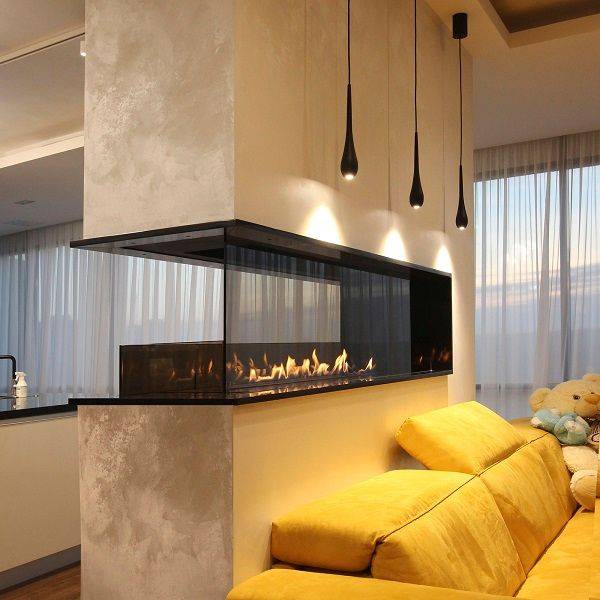
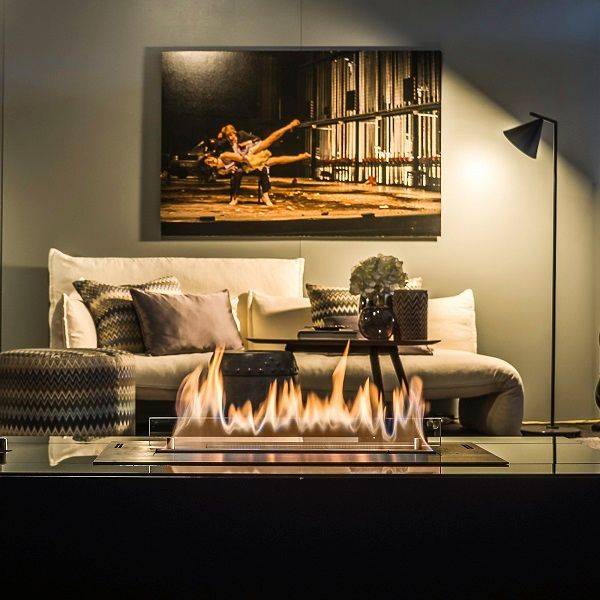
What to drown with?
European countries such as Italy, France and Germany can boast of mass production of ecofuel, South Africa produces biofuels in Africa, and Brazil occupies a leading position in the world. China and India produce about 5% of the total amount of bioethanol.
On the territory of the former USSR, at the moment, the production of this substance is almost not established. For ethanol production, crops such as potatoes, beets, and Jerusalem artichoke are considered as alternative sources.
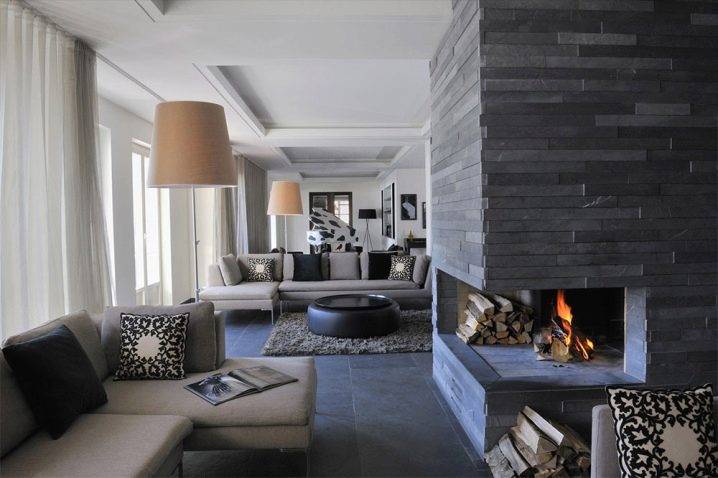
Fuel is divided into several types, among the most popular are the following:
- Biogas. This is a pre-processed industrial waste, which is analogous to natural gas.
- Biodiesel is the most common in European countries. The source is natural oils and fats of biological origin, both animal and microbial or vegetable. Various waste products from the food industry or oils are used as raw materials.
- Bioethanol replaces gasoline.
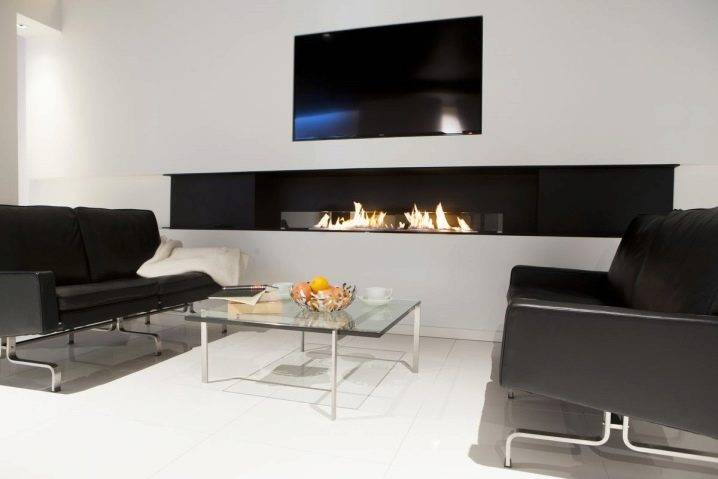
To ignite fireplaces, biofuels are used - a colorless liquid fuel based on bioethanol, which is practically odorless, does not emit solid decomposition products and, as a result, is safe for indoor use. The efficiency of such a liquid is about 95%.
This fuel is based on ethanol, which is of plant origin.The method of obtaining is the fermentation of sugars contained in most agricultural crops (beets, cane, bananas, wheat and others). This type of fuel is not sold in its pure form, since the manufacturer is obliged to pre-denature the alcohol in order to protect the fuel for the environment in general and for humans in particular.
Fuel blocks are made of metal, stainless steel is often used for this purpose.

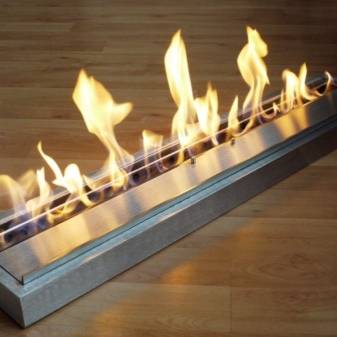
I would like to note the following characteristics of biofuels:
- ease of use;
- long burning;
- lack of emission of harmful gases;
- economical consumption: biofireplace consumes about 0.5 liters of liquid per hour, which is comparable in power to the operation of an electric heater, while the heater dries the air in the room, and the fireplace, on the contrary, humidifies;
- does not require special storage space
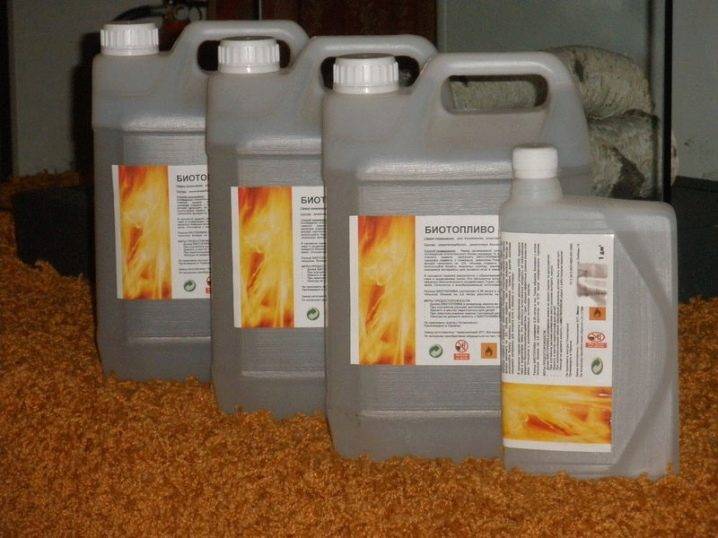
Be sure to pay attention to the disadvantages that this type of fuel still has:
- in no case store containers with fuel in the immediate vicinity of an open flame;
- it is strictly forbidden to add fuel while the fireplace is in operation - it is necessary to extinguish it and allow it to cool;
- to produce a spark, use a special lighter or electric igniter.

To complement the ambience with a sophisticated scent, you can add essential oil to the decorative elements of the fireplace.
Remember that 95% of the fuel consists of bioethanol, which is a flammable substance, so you need to take safety measures:
- keep it out of the reach of children;
- do not use paper, straw and other flammable materials for ignition of the biochamber;
- do not store in the immediate vicinity of open flame sources.
When choosing biofuels, pay attention to the following points:
- time of complete burnout;
- high heat output;
- availability of certificates confirming quality;
- shelf life;
- genuine packaging;
- there should be no sharp or unpleasant odors.
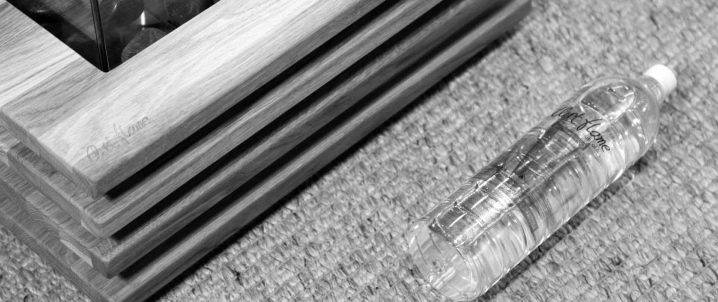
Eco-fuel can also be presented in the form of a gel, which is also very easy to use. The lid is opened, the container is hidden among the heat-resistant decorative elements and is set on fire, the gel will burn for about three hours.

Decorating false fireplaces
When decorating, the following means are used:
- Paper and cardboard. Suitable for those who can draw;
- Wallpaper. Cheap and practical material;
- Textile. A non-trivial option that will emphasize the "artificiality" of the imitation;
- Wood veneer. Lightweight material that will not weigh down the structure and give it a neat look;
- Styrofoam. It is pliable, therefore, with the help of a soldering iron, an original relief is easily created;
- Artificial stone or brick. Suitable for false fireplaces with a "claim" to be as close to the original as possible.

This list is not final, since any of the materials at hand can become part of the structure. All it takes is fantasy.
Fireplace in the interior of the living room
Whichever option you choose, aesthetically, a fireplace and a biofireplace are very similar. And one question remains: where is it better to arrange them?
The most popular option is the living room, because it is there that the whole family and its guests gather, and the task of the live fire in the house is to unite all the neighborhood itself.
Depending on the style of your interior, you can choose a classic or modern option. Now on the market you can find models of various shapes that will fit into any interior.

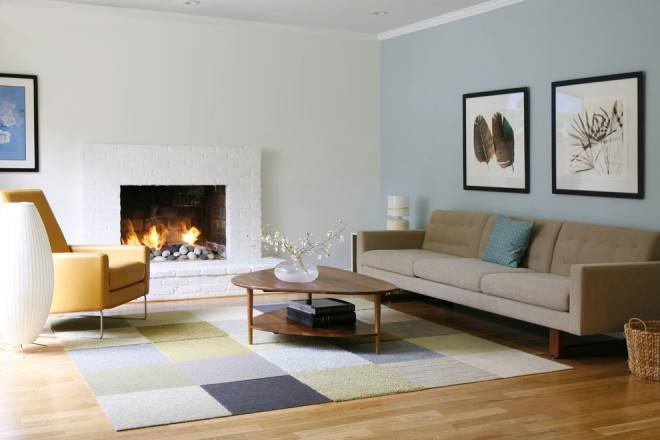
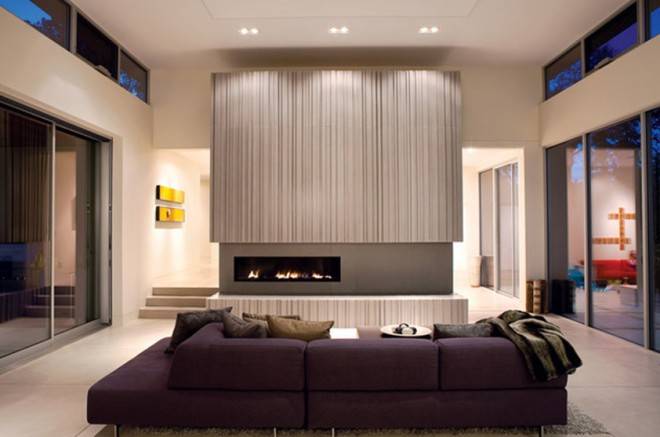

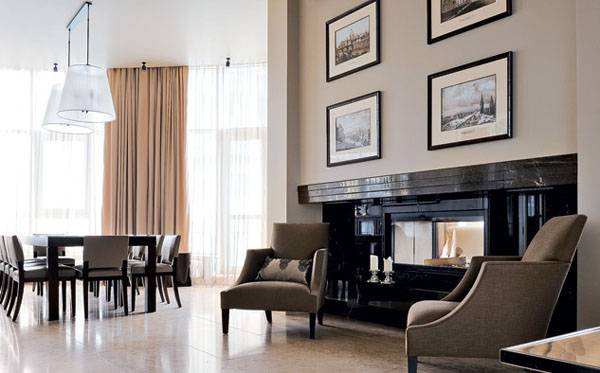
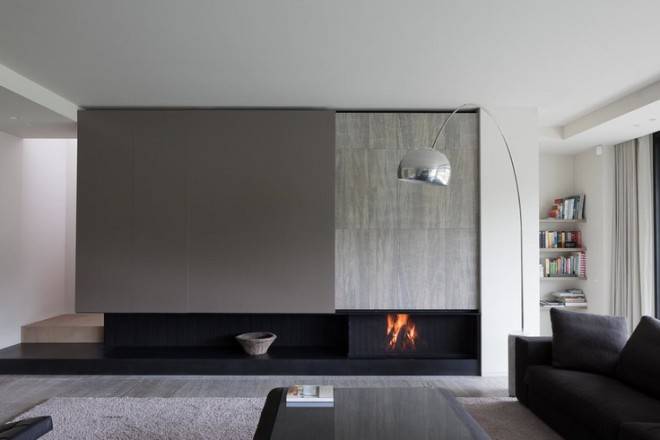
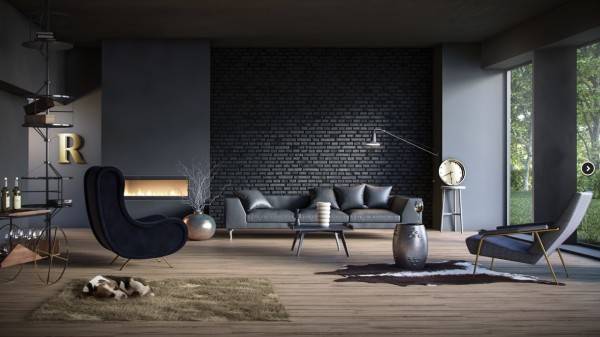
If you want the biofireplace to look believable, then it is better to build it into a drywall or foam block box, which will simulate a chimney. Such a box can be faced with stone or clinker.
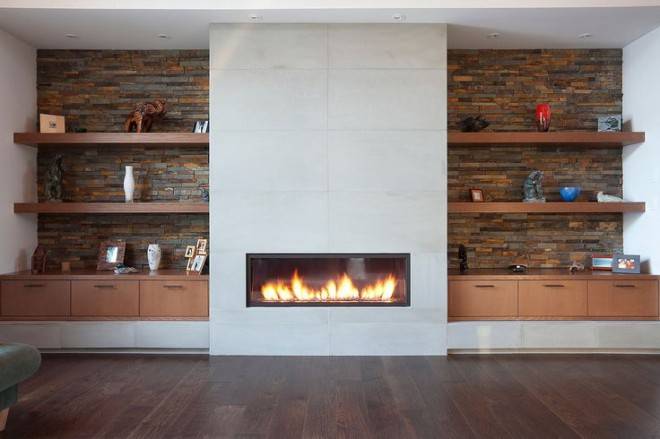
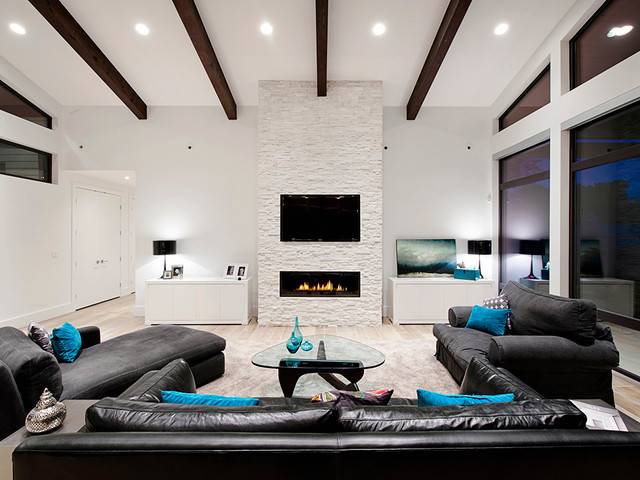
The fireplace in the living room design can be used in a variety of ways.It can be not only a standard firebox framed by a portal, but also more functional solutions, for example, a two-sided fireplace built into a partition that separates different zones.
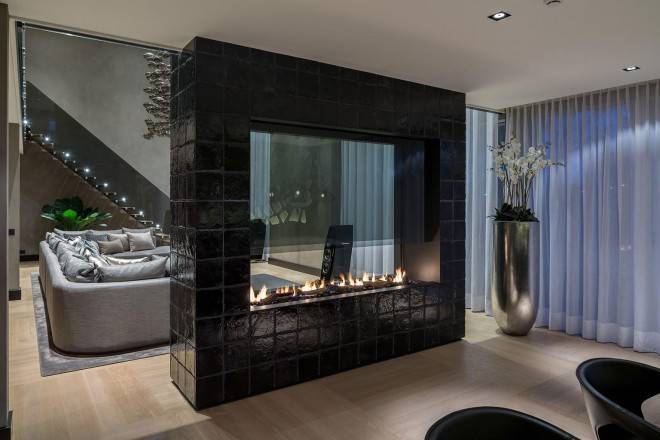
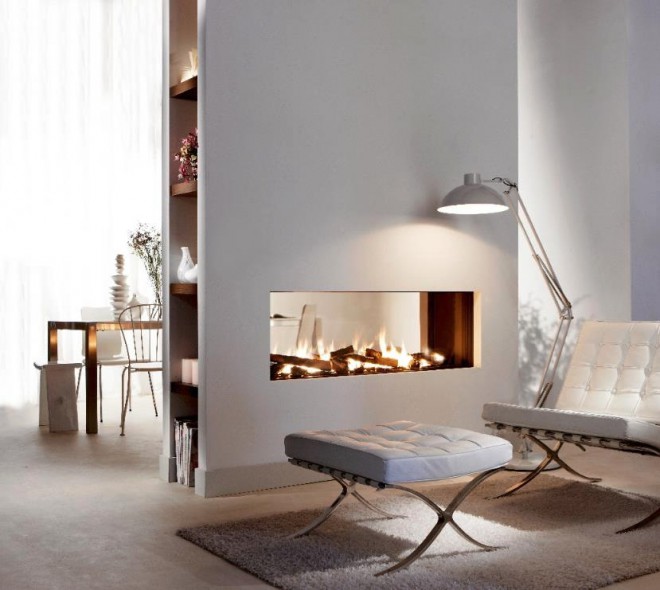
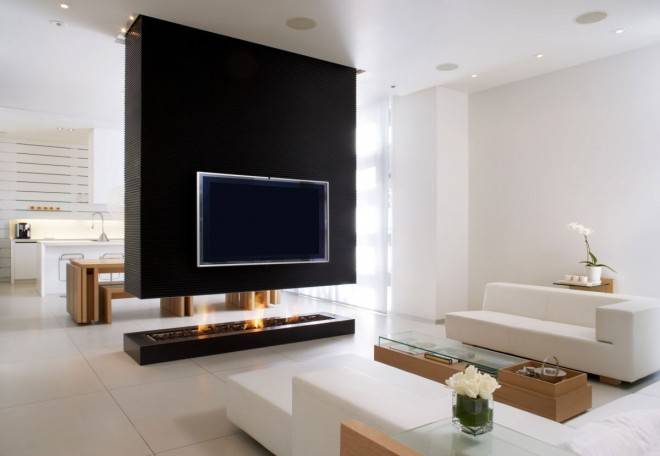
An interesting solution is island fireplaces, but they require more space.


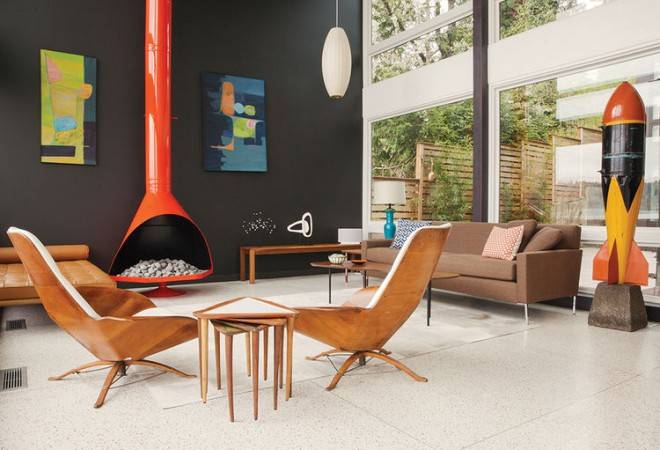
In this sense, free-standing biofireplaces are much smaller in size.


Peculiarities
Compared to traditional fireplaces, the biofireplace has the following advantages:
- Safety - the design of the fuel block makes it possible to control the open fire area. Thermal insulation of the body allows you to use the fireplace in closed rooms.
- Ease of installation - the fireplace does not need a chimney. In relation to the unit, the prefix "eco" is often used, so there is no point in laying ventilation pipes and coordinating work of this nature if there is a desire to install it in an apartment. According to the principle of operation, a bio fireplace is similar to an ordinary candle, but the fire does not give soot. This device runs on biofuel and uses bioethanol as fuel - a liquid based on ethanol, that is, ethyl alcohol, which decomposes into carbon dioxide and water when burning, so there is no shade of orange in the flame. At the moment, there are mixtures containing components to give the fire a natural color. Some biofireplace owners like to use gelled lighter fluid containing sea salt, which simulates the crackling sound of logs on fire.
- It will not be difficult to light up such a fireplace.
- The fireplace is safe for humans, does not harm pets and the environment.
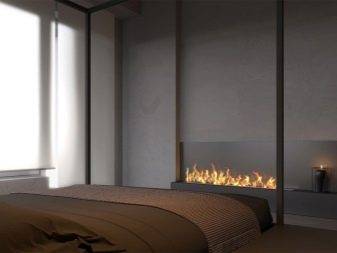
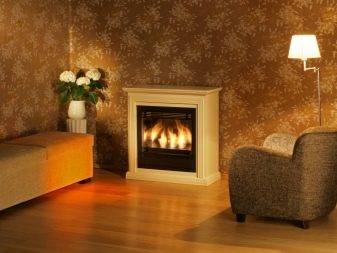
- Easy to use and easy to clean. The flame can be extinguished at any time. Since bioethanol does not produce solid decomposition products, there is no need to scrub ash or soot. To care for the heating tank, simply wash it under running water. The fireplace can be simply lit without worrying about the preliminary preparation of coal or logs.
- A huge variety of models makes it possible to choose the ideal option for any interior.
- Light weight - even the heaviest models weigh no more than 100 kg, which is suitable even for an ordinary city apartment.
- Relative fire safety - it is quite difficult to knock over the fireplace because of its severity, the flame itself looks like a household spirit lamp. In any case, it is necessary to observe fire safety measures, namely, do not add fuel directly during the operation of the biofireplace, do not fill the burner with biofuel by more than a third, use an automatic ignition system or use a specialized lighter.
Biofireplaces are decorated with all kinds of materials - from stone and marble to precious woods; a combination of any types of finishes is also used.
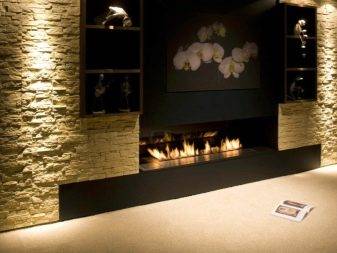
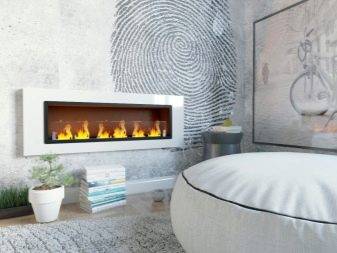
When buying an eco-fireplace, it is reasonable to take into account the disadvantages of this type of interior element:
- The fireplace has an exclusively decorative function - such equipment is not suitable for heating even a small room.
- Despite the environmental friendliness of the fuel and due to the absence of a chimney, there must be good ventilation in the room where the eco-fireplace is installed. Otherwise, the air will become excessively humid and, as a result, unsuitable for breathing.
- Fuel is not available everywhere, and besides, it has a rather high price.
Eco fireplace installation requirements:
- good ventilation in the room;
- lack of drafts;
- sufficient area of the room.
"Variety of bio fireplaces for an apartment"
Like any fireplaces, they are divided according to the type of installation. Distinguish:
- wall-mounted;
- suspended;
- floor models.
In turn, floor and wall fireplaces can be built-in and stand-alone. Buying a side fireplace, you are purchasing a set, a ready-made design solution. Choosing a built-in one, you must design it with a portal, which is sold separately - however, supporters of minimalism can do without it. By the way, a portal for a biofireplace, like a false fireplace, can be made with your own hands, creating bold and even ironic compositions, as in the illustration below.
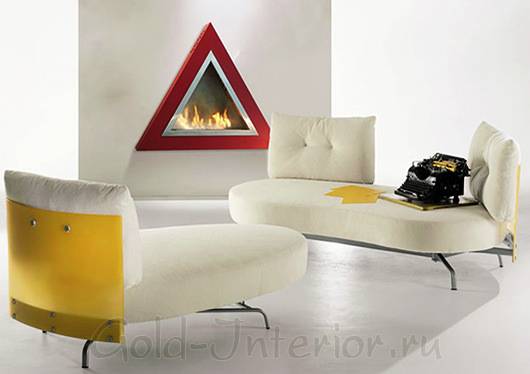
An interesting solution can be a stand-alone two-sided fireplace, which at the same time will take over the function of space zoning. It will be possible not to bother organizing a "fireplace corner", because the flame will be available for viewing to everyone in the room
The only thing is that it is important to comply with fire regulations and maintain the prescribed distance to all objects in the room, so such a fireplace is suitable for an open plan, at home or in a loft.
What is an electric fireplace?
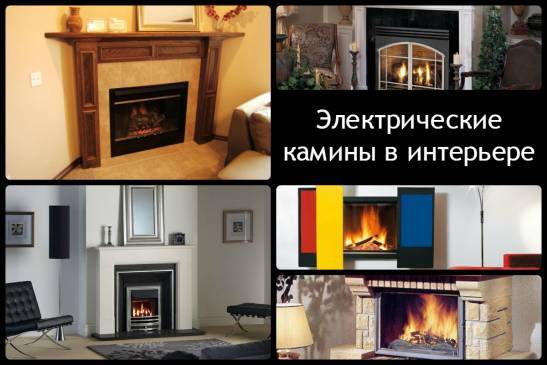
An electric fireplace is a rather complex device in its design. It was created as an imitation of an ordinary fireplace. Electric fireplaces copy not only visual effects, such as flames and backlighting of wood from the heat, but also thermal ones.
Thus, nothing prevents you, as in the good old days, to take a blanket, cocoa in winter and warm yourself in an armchair near the fireplace.
In the heater mode, such fireplaces consume a lot of energy - about 1 to 2 kW of electricity for a room up to 25 square meters. All modern models have a visual function and a heater mode independent of each other. In addition, as a rule, several visual effects are programmed on such fireplaces at once - burning firewood, just firewood, smoldering firewood, coals and embers. So you can choose the most suitable composition for the interior and mood.
Manufacturers offer a variety of variations of these fireplaces, which are made in different styles. You can find imitation of classic stone fireplaces, or you can even find non-standard high-tech fireplaces. The sizes of these devices can be very different, ranging from miniature models to fairly large specimens.
"Advantages and disadvantages of biofireplaces"
The ease of use of biofireplaces is not an unambiguous recommendation for purchase. Study the pros and cons of this unit to make the final decision with your eyes open.
"Advantages"
- Installation prostate, without repair, chimney construction and ventilation organization.
- Environmental safety - harmful compounds and soot simply have nowhere to come from.
- Mobility - you can arrange a fireplace in the interior of a living room, bedroom or dining room, estimate several options and choose the best one. They can also be installed outside the house - a terrace, veranda, courtyard can be easily decorated with real fire.
- No need to coordinate the installation of a biofireplace for an apartment with housing authorities.
- The ability to scent the room - some models are equipped with special bumpers, where essential oil is poured, which dissipates a pleasant smell when heated.
- The opportunity to watch the dance of live fire - gas and, all the more, wood-burning fireplaces in the interior of a city apartment is very difficult to install, so a biofireplace remains the most preferable option.
"Disadvantages"
- The main disadvantage is that the fireplace cannot be left unattended, like any open fire. For those accustomed to the safety of an electric fireplace, it will be difficult to rebuild.
- The second minus is the price, not only of the fireplace itself, but also of a liter of fuel. Watching the fire, in this case, is not a pleasure for every evening.
- It cannot be used as a heating device, the room is heated, but it is practically not felt.
- Not a fundamental, but, nevertheless, a drawback - the smell of alcohol vapors, but only at the moment of ignition.
Beautiful examples in the interior
Design solutions will satisfy any, even the most demanding taste.

- In accordance with Russian traditions, the fireplace can be tiled with tiles, as an option, you can use porcelain decorative elements or gilded fragments.
- To give the eco-fireplace a national style, you can use stained glass windows, uneven lines, a variety of mosaics.
- Using elements of the medieval style, you can add brutality to the fireplace by means of brick or ceramic cladding. Such elements will give an antique look and add nobility.
- In the classical style, on the contrary, there should be no frills and pretentious elements, only restraint and nobility. Finishes made of wood or natural stone look good; mirrors, paintings or any other large objects can be hung over the fireplace.
- If we are talking about high classics, it makes sense, on the contrary, to emphasize luxury. Venetian plaster, carvings and half columns would be appropriate.
- The biofireplace will perfectly fit into the country style - it is better to arrange it deliberately massively, trim it with forging, weapons, use any references to hunting trophies. Untreated wood or untreated stone works well for cladding.
- The bionics style brings a person back to nature. If the biofireplace is located in such a room, let it be finished in a natural color, using subtle elements and natural materials. Excessive geometry, right angles, static should be avoided.
- Small eco fireplaces can be used as unusual wall decorations.
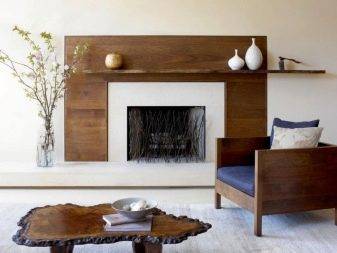
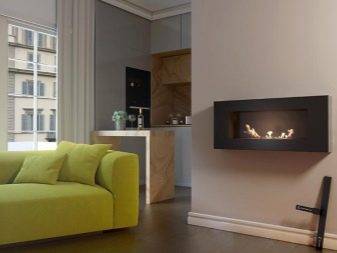
If desired, you can build a small indoor bio fireplace yourself, but remember that safety is above all!
To do this, take a deep bowl or earthen pot, a can of a suitable height, pebbles and a mixture for ignition.
Place a jar in the center of the pot, sprinkle pebbles around, sand or small stones are also suitable. Secure the can carefully to avoid tipping over and catching fire. Pour fuel and light it - a small fireplace is ready. But be extremely careful - open fire is dangerous!
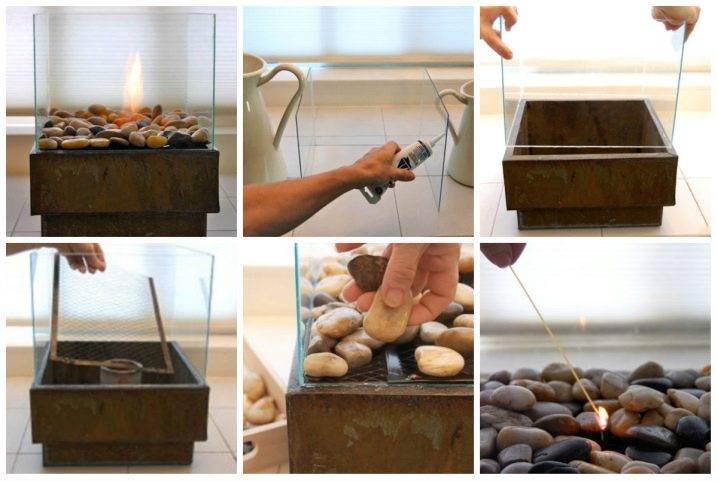
For more information on how to make a biofireplace with your own hands, see the video below.
Device classification by location
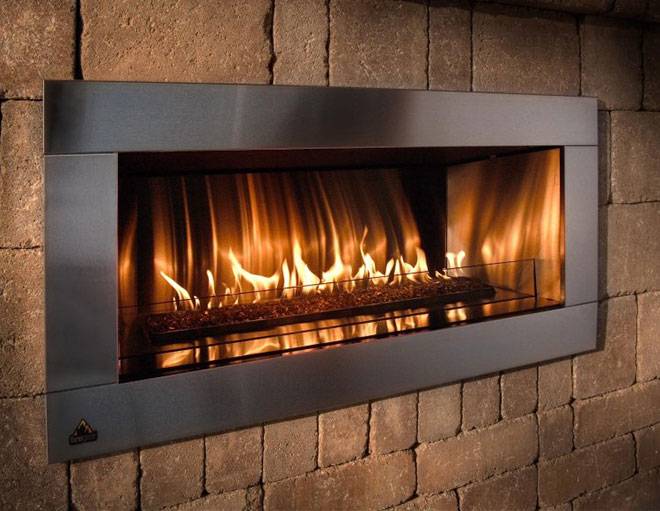
It is customary to distinguish several main classes among built-in biofireplaces:
- Floor products... As a rule, these are stationary systems that are installed on the base of the floor, without preliminary surface preparation;
- Wall mounted fireplaces... They are used as an element of interior design, they allow imitating almost any finishing material, and therefore they are perfectly embedded in the room. They are not used as a source of heating and perform only a decorative role;
- Desktop options... Are the smallest. However, it is the most compact and convenient solution that emits a significant amount of heat and creates a special atmosphere in the room;
- Street options... They are part of the gazebos, terraces and other objects that are located on the personal plot;
- Interior elements... Such products are skillfully selected as design elements in complex layouts and can serve for many years without maintenance;
- Corner... They are used for installation in walls and for maintaining fire over a large area. Such options are most often installed in country houses and cottages. Significant size allows you to sit quite comfortably near the fireplace and keep warm.
The options for a built-in bio fireplace in the wall can be divided into two types:
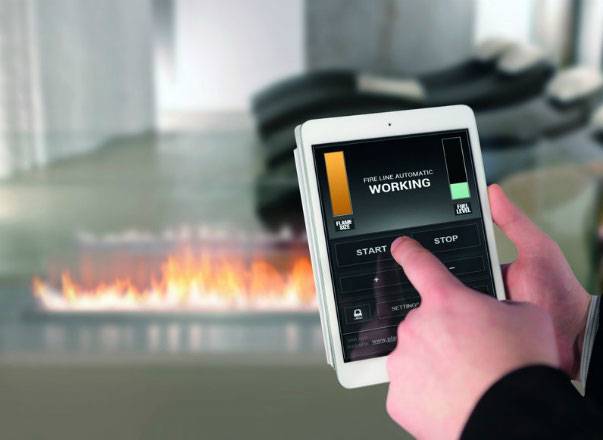 Bio fireplace with automatic flame control
Bio fireplace with automatic flame control
- Manual. Such products require regular refueling and allow you to remember the old traditions of making a fire;
- Automatic. Allows to perform all functions in automatic mode. All the procedures for the ignition and operation of the device are transferred to the devices, the user will only have to enjoy the warmth.
It is worth saying that the operation of both devices provides for the possibility of kindling and extinguishing a fire.
Step-by-step instructions for the device of a biofireplace
Once the burner is complete, you can proceed to the following steps:
- the glass is fixed to each other with a silicone sealant in the required configuration. Leave to dry for a day or more.
- the burner is hidden in a rectangular metal box;
- a can of liquid fuel is placed inside the burner;
- a wick is lowered inside a can of fuel;
- the burner is covered with a net and decorated with decorative elements.
- a glass screen is installed in front of the flame to ensure fire safety;
- use only special biofuels from well-known manufacturers.
In the end, you just need to light the bio fireplace and enjoy the romantic atmosphere, comfort and coziness in the apartment.
Biofireplace built into the wall: 5 positive sides
Before you create a biofireplace at home, you need to familiarize yourself with its positive and negative sides, as well as find out its effect on the appearance of the overall interior. These questions should be of interest to those who are serious about purchasing and want to decorate their home.
Due to the simplicity of the device, manufacturers produce models with various configurations. Bio fireplaces are equipped with a number of advantages that can push a person to purchase.
 Biofireplace built into the wall, well suited for small rooms
Biofireplace built into the wall, well suited for small rooms
There are 5 main advantages to be highlighted:
Fast assembly and easy installation, which do not require approval from certain regulatory authorities. Installation of such a fireplace does not require the laying of additional communication elements.
The bio fireplace is easy to use, it can be switched on even without instructions. For work, it is enough to add fuel and ignite.
This setup can be matched to any finished interior or style.
In any case, the fireplace will become a central object that will attract attention.
Remote monitoring capability facilitates operation. The most modern safety equipment is used for remote control.
If we talk about aesthetics, then such a fireplace can always bring extremely positive emotions into the house.
After sitting by such a fireplace, you can always get a psychologically positive mood and peace.
Choosing a biofireplace built into furniture
Another large group, which also needs to be paid attention to, is biofireplaces built into furniture. Such models are used most often in rooms with a small area, in which the owners strive to create coziness and warmth.
Most often, such models are embedded in horizontal surfaces. This could be a coffee table, a table top, or a large family table.
 Biofireplace built into furniture is perfect for interiors with a modern design
Biofireplace built into furniture is perfect for interiors with a modern design
By placing such a fireplace in the table, you can observe the beautiful tongues of flame, while you should not be afraid that the table will lose its direct functionality. Basically biofireplaces build in kitchen furniture or living room furniture. In these situations, the fireplace also does not violate functionality, but on the contrary adds a special flavor to the furniture.
This biofireplace model is especially effective for an apartment, where every meter is counted. Installing a fireplace in furniture is quite safe, and this is due to the fact that all systems are equipped with control sensors. If an unforeseen situation arises, they will automatically turn off the fireplace. But this does not mean at all that materials prone to light inflammation can be placed next to the installation.
Design features and principles of operation of the biofireplace
The bio prefix indicates that such a fireplace runs on environmentally friendly and safe fuel (usually industrial alcohol produced from agricultural crops). The fuel can be liquid or gel-like. When such fuel is burned, no smoke or soot is formed, but carbon dioxide and water are released.At the same time, the concentration of released substances is so low that they do not pose a threat to human health and well-being. Fuel consumption is quite economical, depending on the size of the fireplace, however, it does not exceed half a liter per hour.

The heart of the bio fireplace is a burner that can be combined with a fuel tank
The biofireplace design usually includes the following elements:
- a tank or compartment for fuel (in its manufacture, stainless steel with a thickness of at least 2 mm is used);
- burner (it can be capillary, wick or gravity);
- body made of refractory materials (metal, special glass, ceramics, stone).
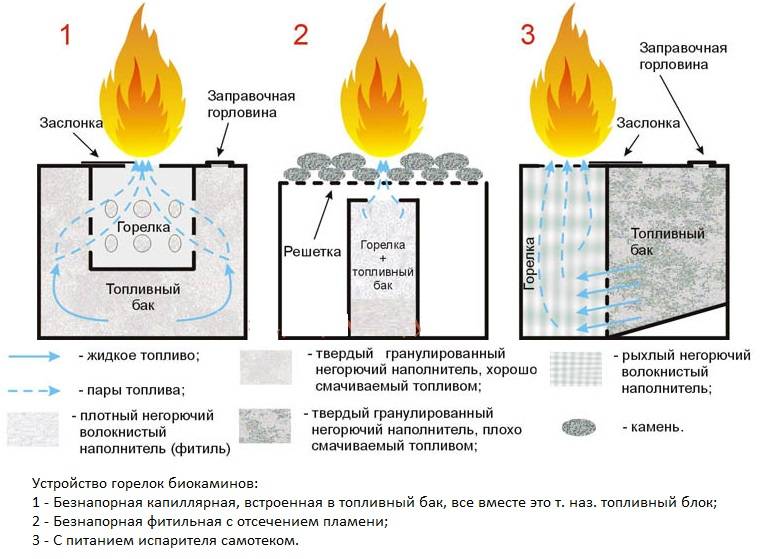
Biofireplace burners device
The principle of operation of such devices is quite simple: biofuel is poured into a special tank, then the burner is ignited with a lighter. Ceramic wool is used to meter the biofuel feed into the burner. A special damper or cap is used to extinguish the flame.
The intensity of the flame depends on the size of the fuel tank and the design of the device, and can also be adjusted by the user.
Depending on the cost, the complete set can be replenished with a remote control. It can be used to control the intensity of the flame, as well as the process of ignition and stopping the combustion. Also, decorative logs made of ceramics or stones are added to biofireplaces to create a more spectacular appearance. The bio fireplace can be supplemented with a sound device that simulates the crackling of wood when burning to create maximum naturalness.
Types of devices
Biological fireplaces can be easily classified according to their appearance and installation options. Today it is easy to distinguish four main groups: table, floor, wall and outdoor fireplaces. Let's take a look at each group in order.
Wall-mounted devices
Wall-mounted bio fireplaces have a clear form factor that allows them to be successfully fixed on a flat wall in a suspended state. For this, one side of the device is flat and has special fasteners. The convex shape of the device on the other hand can be any: square or round, triangular or elliptical. Designer biofireplaces often have completely incomprehensible outlines, which does not prevent them from being successfully placed in the interior.
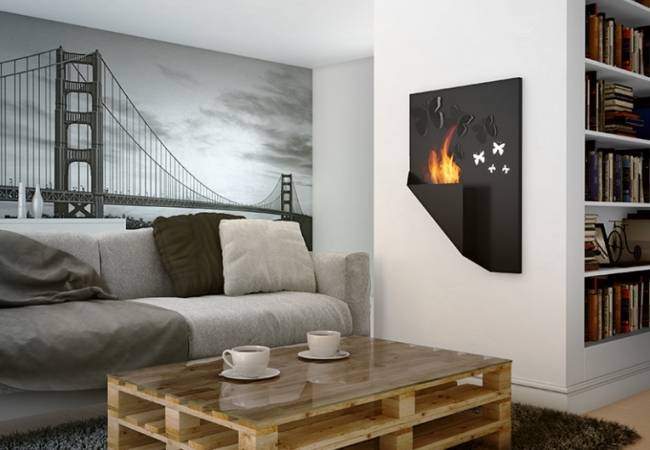
Original glass biofireplace hanging type
Floor appliances
Floor biofireplaces can be quite diverse. They are performed either in any form for installation anywhere in the apartment, or in an angular version. The portals of such fireplaces have significant dimensions in order to protect the surrounding space from the harmful effects of fire. Usually they are made of transparent fire-resistant glass, through which it is convenient to admire the fire from any angle.
Note that often floor fireplaces are equipped with a sound system, which allows you to convey in more detail the atmosphere of burning real firewood. In some cases, such fireplaces are mounted in the walls so that you can admire the fire in two rooms at once.

Small mobile biofireplace for home use
Desktop devices
The desktop bio-fireplace has become an evolutionary development of the outdoor one. In principle, it is no different from its big brother, only it has small dimensions. This fireplace can be successfully considered a decorative element designed to create the necessary atmosphere in the room. However, in this case, there is also some functionality that allows you to admire a real fiery flame on your table.
Such small eco-fireplaces in the interior of any room with any design can look great, therefore, they are a worthy gift that they may well present to you.
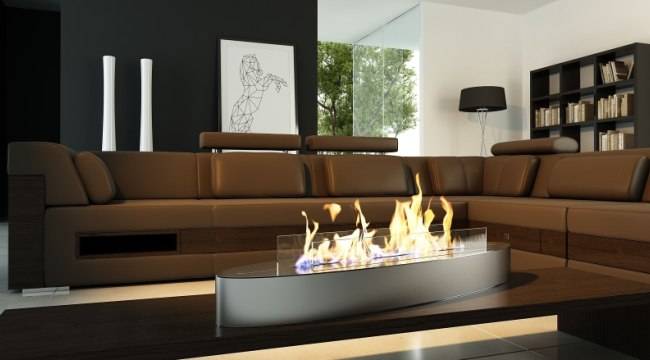
Elongated biofireplace for a large table in the living room
Street options
For private houses and large apartments, fireplaces are provided, which can be installed on the balcony or loggia, in front of the house, on the terrace. Usually these biofireplaces are of impressive size, especially in the area of the portal.In such devices, the combustion of fire is not limited, so we can observe a full flame.
Conclusions and useful video
Important parameters when buying an eco fireplace
- Power. The more powerful the fireplace, the stronger the heat transfer
- Fuel tank size. Here you need to approach from the point of view of operating time. The longer the time of using the bio fireplace, the larger the tank. For an hour of using a medium-sized biofireplace, from 350 ml to 1 liter of fuel is consumed. Leaving fuel inside the fireplace is undesirable;
- Burner material. It can be ceramic or stainless steel.
Biofireplace is a high quality decor. He will be the main highlight in your room, which will create a unique atmosphere.
